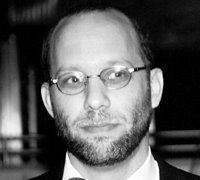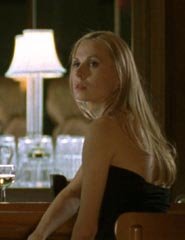 Here's an interview I conducted with the director of the Sundance winner of the 2005 Grand Jury Prize, Ira Sachs (pictured), whose film 40 Shades of Blue opens in the UK today. I shower Sachs with praise and he deserves that. Go see his film. It's a very rewarding film experience. This interview was published yesterday on Kamera, an independent film site I edit.
Here's an interview I conducted with the director of the Sundance winner of the 2005 Grand Jury Prize, Ira Sachs (pictured), whose film 40 Shades of Blue opens in the UK today. I shower Sachs with praise and he deserves that. Go see his film. It's a very rewarding film experience. This interview was published yesterday on Kamera, an independent film site I edit.Occasionally we come across a film that hits us like a mesmerising surprise, one of those films that feel more like a real life experience than the mere contemplation of a sequence of images. This is the case with Ira Sachs's 40 Shades of Blue (out in the UK on 30 June), his long overdue follow-up to The Delta (1996). The film won last year's Sundance Grand Jury Prize and has been heaping deserved praise in America ever since. Set in Sachs's native Memphis (he's based in New York now), 40 Shades of Blue is redolent of vintage European arthouse cinema (Rainer Wainer Fassbinder, early Ken Loach) and John Cassavetes in America.
Sachs, 41, says his love affair with cinema started when he was a student in France. "I didn't go to film school so I have a very aficionado approach. When I was living in Paris in the 1980s as a student, and students are always lonely, I think I saw 200 films in three months. I think [not having formal training] is definitely an advantage because I have no concept of what's right". Wherever the roots of his cinematic genius lie, Sachs achieved with 40 Shades of Blue a rare feat for a male director, which is to create a genuinely feminine narrative point of view. The film focuses on the moment when sad-eyed Michael (Darren E. Burrows), the son of Memphis music veteran and legend, Alan James (played by a satyr-like Rip Torn), comes back to visit his father and his young Russian girlfriend Laura (played by the unforgettable Russian actress Dina Korzun). It becomes clear that Michael and Alan's relationship has a history of pain. But the film is Laura's and the audience goes along with her through a process triggered by Michael's arrival that will result in a cathartic self-discovery.
"We worked for six years on the script, which started as a slice-of-life type of story. The idea from the film came experiences in my childhood. I grew up with a larger-than-life father who had lots of women. My initial intention was to make an amalgamation of the different women who I met, take the camera away from the guy and focus on the woman. My co-writer Michael Rohatyn then turned the story into fiction," says Ira, who is currently shooting The Marriage, based on the British pulp mystery novel "Five Roundabouts to Heaven".
Central to the film's effectiveness and its atmosphere, sometimes so evocative that you can almost smell the time-warp of a house where Alan and Laura live, is its cinematography, simultaneously intimate and detached and almost three-dimensional in its configuration of space. "I chose the cinematographer Julian Whatley after I saw a video he made for the band Green Day, Time of Your Life. I was struck by his use of light. He's a very creative DOP. We put the camera in the corner of the room to allow the actors more space to play out their parts. And I didn't want to use digital; it was important for the emotional impact of the film." Besides, all the cast give consistently good performances and special mention should go to Korzun for her meticulous yet un-mannered rendering of Laura. "The most important thing is to cast well," says Sachs. "I'm very happy with the performances. We rehearsed very little, if at all. I felt that I wanted to leave some room for the performers to feel alive and that's why I think the film has a mystery, like there's something about to happen."
Sachs wears his European influences on his sleeves and even cast Paprika Steen, the Danish actress who played one of the main characters in Festen (Thomas Vintherberg, 1999), for a supporting role. Did he want to make a clear reference to a film he admires? "It was not so much a reference but actually a steal. I remember her performance in Festen and so I cast her as an Euro rock singer". Sachs says his influences go beyond film, though. "They go further back than cinema, to the novels of Henry James, the portrait novel. I'm interested in how can you focus attention on the character and make it be about the audience as well. In Cassavetes and Ken Loach's films there is an authenticity to the performers, a kind of loving. I see myself more engaged to the legacy of the 1970s than the independent cinema scene that emerged in the 1990s. I felt very involved as a gay filmmaker in the questions that were happening in the late 1980s, the New Queer Cinema. We collectively internalised the work of more radical filmmakers." Sachs walks the walk when it comes to keeping independence: he is a member of the Dependent Cinema collective, a loose group of directors, including Karim Ainouz (Madame Satã), Jonathan Nossiter (Mondovino) and Oren Moverman (Hiding Place) who help each other out on a informal basis.
Did receiving a Sundance award ignite significant changes? "There's a certain kind of affirmation on a personal level. On a professional level it doesn't mean that much. It's very hard to make movies, people will make it hard for you; this is the part of you that likes awards. The critical reception has been much better than I thought it would be. It's an art film and there are not a lot of art films being made."
When watching 40 Forty Shades of Blue you get the impression of being a witness to some kind of truth pattern forming in front of your eyes, an unflinching type of emotional realism. How can the medium of cinema be used in the quest for the truth, to extract it from underneath the surface of images? "I was in psychoanalysis for many years, and for me it was the perfect training for making films. In a good analysis, what you develop in the process is not only a better understanding of yourself, but also a greater empathy and analytic ability for understanding others. That's one of the reasons why Freud thought it was so important for analysts to go through the process themselves. What is directing but listening very closely to others and trying to guide people to certain moments of self-revelation? I don't exactly believe in a concept of truth. I am more interested in what I would consider detail: the ability to break down any one moment into a thousand little pieces of experience. This is what I look for in film. Not a conscious and theoretical explanation of why people do what they do, but a reportage of that complexity, that depth, perhaps unspoken but always present and tangible on the screen".
40 Shades of Blue is out in the UK on 30/06/06.





